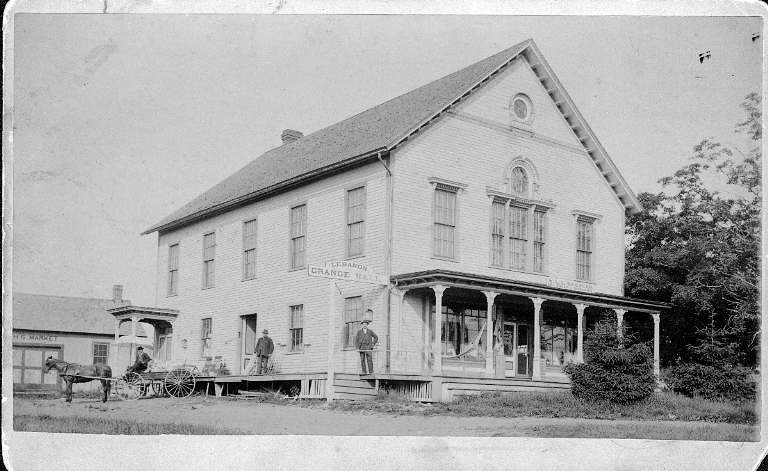By Donna K. Baron
Founded in 1884, the Lebanon Grange provided social and educational opportunities for local farm families. Lebanon Grange members took advantage of the national organization’s membership structure and agricultural information without participating in much of the political agenda that characterized Grange activities elsewhere.
The National Movement
The National Grange of the Patrons of Husbandry formed in Washington, DC, on December 4, 1867. Known more commonly as the Grange, this cooperative society for US farmers sought to further their rights and to provide for their social, economic, legislative, and educational needs. Although modeled after Freemasonry, a fraternal organization, the Grange offered equal membership to women.
The Grange movement proved popular in the Midwest, West, and South but took longer to take root in New England. The financial Panic of 1873—and the four-year economic depression that followed—stimulated Grange formation in the region as farmers struggled with the lack of credit, fluctuating crop prices, and rising costs. The Connecticut State Grange, first established in 1875, soon foundered but successfully re-formed in 1885.
Lebanon Embraces Cooperative Model

Page from minutes journal of the Lebanon Grange, November 1893-July 1907 –Lebanon Historical Society
Prior to the Grange Movement, Lebanon had an active Farmers Club that investigated cooperative approaches to shared problems and sponsored events such as the town’s first agricultural fairs in the 1860s. Thus, the Grange movement found a ready base within Lebanon. In March of 1884, the Club invited a Grange member from New Jersey to speak on the national organization’s benefits and soon thereafter local residents formed Connecticut Grange #21. They built a hall to house a cooperative store and meeting space later that same year. Starting with 11 women and 14 men as charter members, the Lebanon Grange roster soon reached 200.
Minutes for the organization reveal that activities included reports from local farmers on experiments they conducted with livestock or crops. In addition to providing a forum where area farmers could share practical, hands-on knowledge originating within the community, the Lebanon Grange also maintained a lending library and reading room so that members could expand their knowledge of agricultural practice. Volumes included such works as Hints to Horse-Keepers: A Complete Manual for Horsemen … And Chapters on Mules and Ponies and Our Farm of Four Acres, and the Money We Made by It, both published in 1859. Meetings also presented opportunities for members to earn advancement through the ranks of the national Grange.
Music Trumps Politics in Lebanon
Nationally, the Grange Movement became involved in important political issues of the day. These included the exploitative practices of banks, merchants, and railroads that eroded farmers’ rights and profits. In Lebanon, however, the focus remained largely on the educational and social opportunities that membership afforded.

Four generations of the Taylor family; May Kimball Taylor seated in rocker, 1938 – Lebanon Historical Society
For instance, meeting minutes reveal that music played a significant role in the Lebanon Grange’s activities. Grange rituals featured special music, and Lebanon meetings also included communal singing of popular songs, solo performances, and occasional concerts by visiting choral or instrumental groups. For example, Grange contributions underwrote an 1894 performance of Esther, The Beautiful Queen, a cantata based on stories from the Bible’s Book of Esther by the Colchester Choral Union. Local talents included May Kimball Taylor, a musician, teacher, and Grange member, who began singing and playing piano at the Lebanon Grange in the late 1890s. (Her collection of sheet music, which spans almost 100 years, now resides in the Lebanon Historical Society’s collections.)
In 1898 the Lebanon Grange acquired an organ from Town Hall. Such a move further underscores the importance members placed on this aspect of community life. In an age where cell phones, mp3 players, and other devices allow us to access music anywhere at any time—often for purposes of tuning out the world—it can be difficult to appreciate music’s central role in strengthening social bonds in the late 19th century. Whether they gathered in homes, churches, or Grange halls, citizens of towns like Lebanon found community as well as enjoyment in the musical entertainments of their day.
Although the Lebanon Grange’s activities peaked in between 1890 and 1950, it remains active today.
Donna K. Baron is director of the Lebanon Historical Society and co-curated its exhibition “Long, Long, Ago”: Lebanon’s History through its Music 1800-1940 with consulting curator Sarah Griswold.









